Venice Baroque Orchestra: Stunning Vivaldi
February 23, 2007
______________________________________________________________________
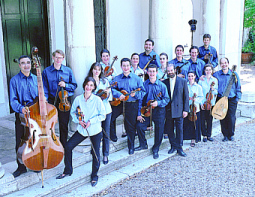
The Washington Post 2/23/07: Pity Antonio Vivaldi. Although he was one of the most imaginative and adventurous of the baroque composers, his reputation has flat-lined under the mass popularity of the "Four Seasons" -- the classical Muzak of malls from Bethesda to Beijing. Decades of courtly performances of his music have numbed untold millions of ears, and he's usually thought of -- when he's thought of at all -- as a skillful (yawn) manufacturer of placid, cookie-cutter concertos.
So it was a revelation to hear the Venice Baroque Orchestra in an (almost) all-Vivaldi program at the Library of Congress on Wednesday. The group's music director, Andrea Marcon, has no use for the "safe" Vivaldi, and he led the ensemble in vivid, nearly reckless performances, tearing the powdered wig off this music once and for all.
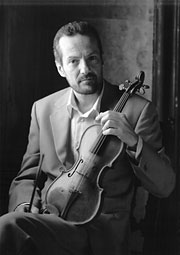 And what was revealed was breathtaking. The three concertos and a sinfonia that opened the program were marvels of invention, surging relentlessly with surprising turns and unexpected harmonies. Full of taut, compressed energy, they absolutely radiated with life -- and Marcon and the ensemble delivered them with electrifying power.
And what was revealed was breathtaking. The three concertos and a sinfonia that opened the program were marvels of invention, surging relentlessly with surprising turns and unexpected harmonies. Full of taut, compressed energy, they absolutely radiated with life -- and Marcon and the ensemble delivered them with electrifying power.
But the playing shifted to an even more exciting level when violinist Giuliano Carmignola took the stage. In a concerto by Giuseppe Tartini and three more by Vivaldi, Carmignola showed himself to be a remarkable virtuoso with an astounding palette of subtle effects and a highly individual voice. A charismatic, high-voltage performer, Carmignola played as if everything were at stake -- often lunging into the music as if in some titanic, life-or-death struggle. And in the end, he triumphed: Vivaldi -- after generations of neglect -- had come furiously back to life.
Mason Bates, Bringing Electronica to the Concert Hall
February 22, 2007
____________________________________________________________
Head down to the Kennedy Center tomorrow night if you can; the young composer Mason Bates is premiering a very intriguing piece called "Liquid Interface." Commissioned by the NSO, it mixes the trip-hop beats of electronica with the textures of a full orchestra, and should be a wild ride -- complete with hurricanes, floods and other magnificent catastrophes.
If that's not hot enough for you, the program also includes violinist Janine Jansen performing Mendelssohn's Concerto in E minor for Violin and Orchestra, Op. 64, which she's just released on Decca. (Thursday, Friday and Saturday at the KenCen Concert Hall -- details here.)
Here's my profile of Mason Bates, from today's Post:

Max Lautenschlager
The Washington Post 2/22/07: Tomorrow night at the Kennedy Center, Al Gore's worst nightmare will come to pass.
Massive glaciers will calve from the ice caps and crash into the sea. Temperatures will rise, boiling the oceans into a fury as the planet gets hotter and hotter -- until finally a massive flood inundates the continents.
That's the apocalyptic plan, anyway, for the premiere of "Liquid Interface," a new work by the young California composer Mason Bates. Commissioned by the National Symphony Orchestra, the piece may be the first attempt to deal musically with the drama of global warming. But that's not the only new thing about this work. Throughout the performance the composer himself will be sitting at the heart of the orchestra, working a laptop and generating huge waves of electronica -- pulsing trip-hop rhythms straight from the dance clubs of the Left Coast.
Wait -- the NSO playing . . . techno?
"There's plenty of rhythmic activity in the piece, and a lot of trip-hop beats," confirms Bates. "But I don't think you'll see people doing head-spins in the aisles."
At age 30, Bates is already rocking the classical world. One of the fastest-rising young composers in the country, he's written a string of serious works for serious orchestras -- including the Los Angeles Philharmonic, the Winston-Salem Symphony and now the NSO -- and won an array of prestigious awards, from the Rome Prize to a fellowship from Tanglewood. Born and reared in Richmond, he trained at Juilliard and is now finishing up a doctorate at the University of California at Berkeley.
By night, Bates heads for the clubs of San Francisco, where as the DJ "Masonic" he churns out driving, sophisticated dance music at places like Skylark and Cloud 9. Armed with a computer and electronic drum pad, he plays into the small hours of the morning, weaving complex, highly rhythmic sonic landscapes.
It would seem to be as far from the concert hall as you could get. But over the last few years, Bates has been bridging the two worlds with a natural ease, writing music that marries the intellectual seriousness of classical with the visceral kick of techno.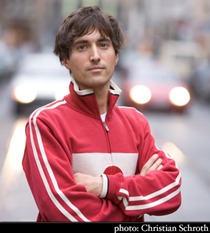 "He's one of the few people who can mix electronica and pop with abstract music, and do it well," says Pulitzer Prize-winning composer John Corigliano. Other composers have tried, he says, usually just dishing up a porridge of "bad classical music and bad pop music at the same time." But Bates's pieces, he says, "are like little jewels -- he inhabits this fantastic sound world."
"He's one of the few people who can mix electronica and pop with abstract music, and do it well," says Pulitzer Prize-winning composer John Corigliano. Other composers have tried, he says, usually just dishing up a porridge of "bad classical music and bad pop music at the same time." But Bates's pieces, he says, "are like little jewels -- he inhabits this fantastic sound world."
Orchestral music and techno are more alike than they seem: They're both instrumental, both are designed for open, cavernous spaces and both have a near-infinite potential for texture and color. Put them together, Bates says, and a world of "very pregnant possibilities" opens up:
"There's a lot of cross-pollination. Orchestral writing changes what you do in electronica, and when you spend any time in an electronic studio, you definitely think about E-flat on the oboe in a new way. And the long spans of time in electronica -- where textures shift very slowly -- change your perspective. My approach to musical architecture has become far more stretched out."
But electronica's most important contribution, says Bates, may be a propulsive, physical energy that's been conspicuously absent from much of the rigidly codified "serious" music of the past 50 years.
"I need to be moved viscerally by a piece of music," he says. "Music's not like any other art form -- you can't escape the physical quality of it. It inhabits your imagination and your bloodstream at the same time. Ultimately I want a piece to pay intellectual dividends -- but I have to be captivated by it first."
In a sense, Bates's mash-up of techno with the orchestra is bringing things full circle. Electronica's roots go back to composers such as Edgard Varese (whose 1958 "Poeme Electronique" may have launched the genre) and Pierre Schaeffer, who used sound samples in the 1950s in a style called "musique concrete." And a few composers of the late 20th century -- the pathbreaking Iannis Xenakis, in particular -- are routinely cited by electronica artists as major influences.
But electronic sounds never caught on in classical music the way they did in pop, where they've blossomed in everything from Top 40 to favela funk. And, since emerging in the 1990s as a style in its own right, electronica has spawned an array of genres and subgenres: acid house, drum 'n' bass, electroclash, booty bass, etc.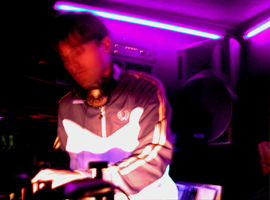 Bates seems uniquely positioned to bring all of this into classical music. "What Mason does is, in a way, a throwback to the 1960s, when composers were first starting to use electronics with the orchestra," says NSO Music Director Leonard Slatkin. "But very rarely were the electronics integrated into the music; they always stuck out as just an added thought. With Mason, they're an integral part of the work."
Bates seems uniquely positioned to bring all of this into classical music. "What Mason does is, in a way, a throwback to the 1960s, when composers were first starting to use electronics with the orchestra," says NSO Music Director Leonard Slatkin. "But very rarely were the electronics integrated into the music; they always stuck out as just an added thought. With Mason, they're an integral part of the work."
Bates first bridged the classical-electronica gulf in a 2004 commission for the Los Angeles Philharmonic, "Omnivorous Furniture." Written for sinfonietta and electronica, the work's success quickly led to more commissions, including a piece for Juilliard's 100th anniversary called "Digital Loom" (for organ and electronica). Word of Bates's talent reached Slatkin, who contacted the composer two years ago to write a 20-minute work.
It was propitious timing; Bates already had an idea for a major piece.
"I was living in Berlin, near a huge lake there called the Wannsee," he recalls. "I had been watching it go through extremes, from totally frozen to hot and humid in a matter of weeks. So I thought it would be fascinating to do a new kind of water piece -- not just Debussy's play of the waves, but a piece on water in all its forms, moving from ice to evaporation.
"And I wanted to look at it through the prism of the 21st century. So the whole piece is structured around things gradually heating up."
When the work premieres tomorrow (in a program that includes the more traditional fare of Mendelssohn's Violin Concerto in E Minor and Tchaikovsky's Symphony No. 6), it will open with a roar -- actual recordings of glaciers calving in the Antarctic -- while the orchestra picks up the imagery, building huge blocks of sound that shift, drift and start to break apart as the temperature rises. As that's happening, says Bates, "the electronics enter with these very fat beats and slow-motion trip-hop beats," based on samples of actual water sounds. Propelled by the beat, the orchestra creates a swirling world of sound, bringing the work to an apocalyptic (or even biblical) flood. But then the waters recede, calm returns, and a simple melody floats over peaceful sounds recorded at the side of the Wannsee, until the final notes simply evaporate away.
"You end up," says Bates, "in a sort of greenhouse paradise, where it's very balmy."
Hold on -- global warming has a happy ending?
"Well, I'm leery of preaching," he says, noting that it was the dramatic aspects of global warming, rather than the politics, that intrigued him. "Absolutely, composers should address the big issues of the day, but I'm not sure a composer is going to have the answers. What's important is to pose the questions."
Soweto Gospel Choir at GMU
February 20, 2007
____________________________________________________________
 The Washington Post 2/20/07: Fresh from winning a Grammy last week for their album "Blessed," the Soweto Gospel Choir put on a show at George Mason University on Sunday that would make a believer out of anyone. Hailing from the township that was at the heart of South Africa's long struggle against apartheid, this choir has the spirit of gospel deep in its blood -- and it shows.
The Washington Post 2/20/07: Fresh from winning a Grammy last week for their album "Blessed," the Soweto Gospel Choir put on a show at George Mason University on Sunday that would make a believer out of anyone. Hailing from the township that was at the heart of South Africa's long struggle against apartheid, this choir has the spirit of gospel deep in its blood -- and it shows.
Singing to celebrate South Africa's first decade of democracy, the group gave a performance almost as physical as it was musical. Dressed in a sunburst of colors, they danced, clapped, drummed and even whistled through a fast-paced program, building song after song to heart-stopping pitches of intensity. And even if you didn't speak the Zulu and Sotho of most of the music, the message was clear: These were songs of profound faith, of hope persisting through the darkest night.
Under the energetic direction of choirmaster Lucas Bok, the group sang to the rafters, with most of the 25 singers taking turns soloing and dancing. There weren't any star turns -- this is an ensemble in every way -- although some of the rubber-limbed dancers did threaten to steal the show. But the focus stayed firmly on the music, particularly during the mesmerizing call-and-response of "Asimbonanga," the Zulu rap rhythms of "Ahuna Ya Tswanang Le Jesu," and the shifting syncopations of "Avulekile Amasango."
There were a few moments that marred the general glory; the pop throwaway "Weeping," with its cheesy electric piano accompaniment, was an embarrassment, as was the goopy, let's-all-hold-hands anthem "World in Union." But those lapses were forgotten in the final moments of the concert, when the choir unleashed a full-throttle rendition of "Oh Happy Day" so soaring and ecstatic it nearly brought down the house.
Way Overdue: Philip Glass Finally in Baltimore
February 18, 2007
_________________________________________________________
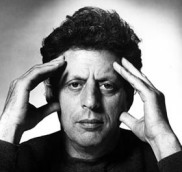 It's taken a while -- three decades, more or less -- but Philip Glass is finally getting the attention he deserves in his hometown of Baltimore. The Baltimore Symphony Orchestra under Marin Alsop will be presenting "Life: A Journey Through Time," a multimedia production with music by Glass and photographs by Frans Lanting, in the East Coast premiere of the work this weekend. Opening Thursday at Strathmore, then moving up to Meyerhoff -- definitely a must-see-hear.
It's taken a while -- three decades, more or less -- but Philip Glass is finally getting the attention he deserves in his hometown of Baltimore. The Baltimore Symphony Orchestra under Marin Alsop will be presenting "Life: A Journey Through Time," a multimedia production with music by Glass and photographs by Frans Lanting, in the East Coast premiere of the work this weekend. Opening Thursday at Strathmore, then moving up to Meyerhoff -- definitely a must-see-hear.
Tim Smith at The Baltimore Sun has a fascinating piece on Glass today, taking a close look at the composer's long neglect in his hometown, his plans for the premiere (he won't be there) and the politics of programming .
Paco de Lucía: Impassioned Flamenco at Lisner
February 12, 2007
___________________________________________________________
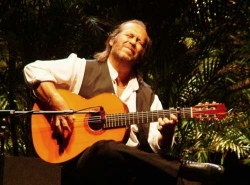 The Washington Post 2/12/07: Is there any music in the world more sensual, more hot-blooded, more searingly human than flamenco? Anyone who heard guitarist Paco de Lucía at Lisner Auditorium on Friday night would be hard-pressed to say anything but no. For more than two hours, de Lucía unleashed a firestorm of Andalusian passion on the sold-out house -- an eloquent and wildly exciting performance that showed why he ranks among the world's greatest guitarists.
The Washington Post 2/12/07: Is there any music in the world more sensual, more hot-blooded, more searingly human than flamenco? Anyone who heard guitarist Paco de Lucía at Lisner Auditorium on Friday night would be hard-pressed to say anything but no. For more than two hours, de Lucía unleashed a firestorm of Andalusian passion on the sold-out house -- an eloquent and wildly exciting performance that showed why he ranks among the world's greatest guitarists.
It was a spectacular launch to George Washington University's seventh annual Flamenco Festival, which continues with performances all week. Opening with a solo "Rodena" -- an introspective work that erupts into sudden dramatic flourishes and sweeping runs -- de Lucía explored a range of his pioneering "new flamenco" compositions, as well as more traditional works.
And all of it was spellbinding. De Lucía's mastery of the flamenco guitar is unequaled, and not only in terms of blinding speed. More impressive is the gravity and profound dignity that lie behind every note -- even the most sensual -- and the subtle inflections that evoke musical landscapes few others can even imagine.
De Lucía was joined in "Solea" by vocalists Chonchi Heredia and Montserrat Cortes -- whose husky cries and moving lamentations felt like they were being torn physically from their bodies -- and by the superb percussionist Israel Suárez (El Piraña) in a furious "Buleria." The entire band joined forces after intermission, with Antonio Serrano taking solos on harmonica that were technically impressive but without much blood in their veins, while bassist Alain Pérez and guitarist Niño Josele played brilliantly and with unrestrained fire.
Emersons & Shostakovich at the Terrace
By Stephen Brookes • The Washington Post • February 2, 2007
___________________________________________________________________________________
 Intense, fiercely beautiful and almost shockingly intimate, the 15 string quartets of Dmitri Shostakovich rank among the 20th century's most powerful works of art. Ambiguous, probing, constantly shifting, they move from ethereal loveliness to bitter satire with the quickness of a snakebite -- and often with the same heart-stopping effect.
Intense, fiercely beautiful and almost shockingly intimate, the 15 string quartets of Dmitri Shostakovich rank among the 20th century's most powerful works of art. Ambiguous, probing, constantly shifting, they move from ethereal loveliness to bitter satire with the quickness of a snakebite -- and often with the same heart-stopping effect.
The Emerson String Quartet has made a specialty of this extraordinary music, performing the full cycle on several occasions and releasing a standard-setting recording of the complete works. So it was no surprise that the Terrace Theater was sold out this week for a series of three performances (covering the first eight quartets), which opened on Monday night with the Quartet No. 1.
 The first isn't the most satisfying of the quartets; even Shostakovich once said that "it didn't turn out particularly well." But that didn't excuse a disappointing performance from the Emersons, who played with their fabled precision but not a lot more. Violinist Eugene Drucker led the group (playing in their trademark standing position, with cellist David Finckel on a small platform) in a professional but rather distant reading, and even the wonderfully Haydnesque finale fell flat. Throughout the Terrace, minds wandered.
The first isn't the most satisfying of the quartets; even Shostakovich once said that "it didn't turn out particularly well." But that didn't excuse a disappointing performance from the Emersons, who played with their fabled precision but not a lot more. Violinist Eugene Drucker led the group (playing in their trademark standing position, with cellist David Finckel on a small platform) in a professional but rather distant reading, and even the wonderfully Haydnesque finale fell flat. Throughout the Terrace, minds wandered.
Interest picked up considerably in the rest of the program, though. The Quartet No. 7 is a short but absolutely fascinating work, an enigmatic memorial that Shostakovich wrote to his first wife. And the Emersons explored it with a fine, intuitive touch, opening up its strange and heartbreaking landscapes with persuasive command. And the Quartet No. 5, which closed the program, was purely magnificent. Violinist Philip Setzer led the quartet in a passionate, headlong reading -- and you could not tear your ears away.
Bashmet's Takemitsu; KTK & the Flying Panties Problem
February 1, 2007
_____________________________________________________________________

Toru TakemitsuAlex Ross has a fine but all-too-short piece on the music of Toru Takemitsu in The New Yorker this week (click here to read) which he describes as "rich in opulent chords, luminous textures, exotic tones that almost brush the skin, hazy melodies that move like figures in mist."
But it's music that's notoriously hard to bring off in live performance, and Ross wasn't too thrilled with the recent Takemitsu offerings at Zankel Hall by Yuri Bashmet and the Moscow Soloists.
"The players had intonation problems from the start," says Ross, "and during the periodic pauses, which should be like intakes of breath, the music simply stopped. Bashmet, who variously played violin and viola and also conducted, was on surer ground when he took the podium to conduct excerpts from three Takemitsu film scores ... music of a more extroverted, popular character ... and the Moscow Soloists dug in with vigor."
We heard a similarly disappointing performance of the same program here at the Library of Congress last week. Bashmet has been a tireless and invaluable promoter and interpreter of contemporary music (his recording of Sofia Gubaidulina's Viola Concerto -- which she wrote for him -- is essential listening), but he and the Moscow Soloists were only really at their best in the meatier works they played.
__________________________________________________________________________
Kiri goes to courtAnd speaking of performance problems: Dame Kiri Te Kanawa has a court date in Oz this week. She's being sued for up to $2 million (Australian) for breach of contract, after suddenly pulling out of a concert tour with Australian popstar/aging heart-throb John Farnham when she learned that his fans sometimes got a bit, um, warm at his concerts.
"It seems she was uncomfortable with the possibility that enflamed female fans might throw panties at the stage while Farnham was singing," reports Playbill.
And Dames don't do that, sorry.
___________________________________________________________________________
 The great Joe Queenan has finished up his serialized "A-Z of Classical Music" in The Guardian -- check out the last entry (with links to previous entries at the bottom of the page).
The great Joe Queenan has finished up his serialized "A-Z of Classical Music" in The Guardian -- check out the last entry (with links to previous entries at the bottom of the page).
Queenen -- a former Spy writer, cultural critic and self-described "sneering churl" -- misses as often as he hits, but when he hits, it's dead on target.

